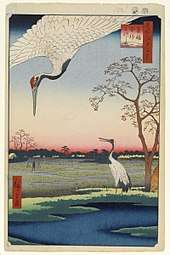Red-crowned crane
The red-crowned crane (Grus japonensis), also called the Manchurian crane or Japanese crane (traditional Chinese: 丹頂鶴; simplified Chinese: 丹顶鹤; pinyin: dāndǐng hè; Japanese: 丹頂鶴 or タンチョウヅル; rōmaji: tanchōzuru; Korean: 두루미; romaja: durumi; the Chinese character '丹' means 'red', '頂/顶' means 'crown' and '鶴/鹤' means 'crane'), is a large East Asian crane among the rarest cranes in the world. In some parts of its range, it is known as a symbol of luck, longevity, and fidelity.
| Red-crowned crane | |
|---|---|
.jpg) | |
| In snow in Hokkaido, Japan | |
| Scientific classification | |
| Kingdom: | Animalia |
| Phylum: | Chordata |
| Class: | Aves |
| Order: | Gruiformes |
| Family: | Gruidae |
| Genus: | Grus |
| Species: | G. japonensis |
| Binomial name | |
| Grus japonensis (Statius Müller, 1776) | |
Description
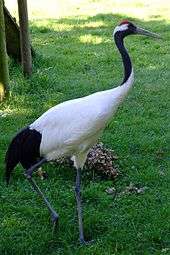
Adult red-crowned cranes are named for a patch of red bare skin on the crown, which becomes brighter during mating season. Overall, they are snow white in color with black on the wing secondaries, which can appear almost like a black tail when the birds are standing, but the real tail feathers are actually white. Males are black on the cheeks, throat, and neck, while females are pearly gray in these spots. The bill is olive green to greenish horn, the legs are slate to grayish black, and the iris is dark brown.[2]
This species is among the largest cranes, typically measuring about 150 to 158 cm (4 ft 11 in to 5 ft 2 in) tall and 101.2–150 cm (3 ft 4 in–4 ft 11 in) in length (from bill to tail tip). Across the large wingspan, the red-crowned crane measures 220–250 cm (7 ft 3 in–8 ft 2 in).[3][4][5][6] Typical body weight can range from 4.8 to 10.5 kg (11 to 23 lb), with males being slightly larger and heavier than females and weight ranging higher just prior to migration.[7][8][9] On average, it is the heaviest crane species, although both the sarus and wattled crane can grow taller and exceed this species in linear measurements.[8][10][11] On average, adult males from Hokkaidō weighed around 8.2 kg (18 lb) and adult females there averaged around 7.3 kg (16 lb), while a Russian study found males averaged 10 kg (22 lb) and females averaged 8.6 kg (19 lb); in some cases, females could outweigh their mates despite the males' slightly larger average body weight. Another study found the average weight of the species to be 8.9 kg (20 lb).[8][12][13] The maximum known weight of the red-crowned crane is 15 kg (33 lb).[14][15] Among standard measurements, the wing chord measures 50.2–74 cm (19.8–29.1 in), the exposed culmen measures 13.5–17.7 cm (5.3–7.0 in), tail length is 21.5–30 cm (8.5–11.8 in), and the tarsus measures 23.7–31.9 cm (9.3–12.6 in).[12]
Range and habitat
In the spring and summer, the migratory populations of the red-crowned crane breed in Siberia (eastern Russia), north-eastern China and occasionally in north-eastern Mongolia[1] (i.e., Mongol Daguur Strictly Protected Area). The breeding range centers in Lake Khanka, on the border of China and Russia. Normally, the crane lays two eggs, with only one surviving. Later, in the fall, they migrate in flocks to the Korean Peninsula and east-central China to spend the winter.[1] Vagrants have also been recorded in Taiwan.[1] In addition to the migratory populations, a resident population is found in eastern Hokkaidō in Japan.[1] This species nests in wetlands and rivers. In the wintering range, their habitat is comprised mainly by paddy fields, grassy tidal flats, and mudflats. In the flats, the birds feed on aquatic invertebrates and, in cold, snowy conditions, the birds switch to mainly living on rice gleanings from the paddy fields.
Ecology and behaviour
Diet

Red-crowned cranes have a highly omnivorous diet, though the dietary preferences have not been fully studied. They eat rice, parsley, carrots, redbuds, acorns, buckwheat and a variety of water plants. The animal matter in their diet consists of fish, including carp and goldfish, amphibians, especially salamanders, snails, crabs, dragonflies, small reptiles, shrimp, small mammals like rodents and small birds like ducklings. They seem to prefer a carnivorous diet, although rice is now essential to survival for wintering birds in Japan and grass seeds are another important food source. While all cranes are omnivorous, per Johnsgard, the two most common crane species today (the sandhill and common cranes) are among the most herbivorous species while the two rarest species (the red-crowned and whooping cranes) are perhaps the most carnivorous species. When feeding on plants, red-crowned cranes exhibit a preference for plants with a high content of crude protein and low content of crude fiber.[16]
They typically forage by keeping their heads close to the ground, jabbing their beaks into mud when they encounter something edible. When capturing fish or other slippery prey, they strike rapidly by extending their necks outward, a feeding style similar to that of the heron. Although animal prey can be swallowed whole, red-crowned cranes more often tear up prey by grasping with their beaks and shaking it vigorously, eating pieces as they fall apart. Most foraging occurs in wet grasslands, cultivated fields, shallow rivers, or on the shores of lakes.
Migration
The population of red-crowned cranes in Japan is mostly non-migratory, with the race in Hokkaidō moving only 150 km (93 mi) to its wintering grounds. Only the mainland population experiences a long-distance migration. They leave their wintering grounds in spring by February and are established on territories by April. In fall, they leave their breeding territories in October and November, with the migration fully over by mid-December.
Sociality
Flock sizes are affected by the small numbers of the red-crowned crane, and given their largely carnivorous diet, some feeding dispersal is needed in natural conditions. Wintering cranes have been observed foraging, variously, in family groups, pairs, and singly, although all roosting is in larger groups (up to 80 individuals) with unrelated cranes. By the early spring, pairs begin to spend more time together, with nonbreeding birds and juveniles dispersing separately. Even while not nesting, red-crowned cranes tend to be aggressive towards conspecifics and maintain a minimum distance of 2 to 3 m (6.6 to 9.8 ft) to keep out of pecking range of other cranes while roosting nocturnally during winter. In circumstances where a crane violates these boundaries, it may be violently attacked.[17]
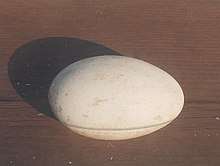
Breeding

Breeding maturity is thought to be reached at 3–4 years of age. All mating and egg-laying is largely restricted to April and early May. A red-crowned crane pair duets in various situations, helping to establish formation and maintenance of the pair bond, as well as territorial advertisement and agonistic signaling. The pair moves rhythmically until they are standing close, throwing their heads back and letting out a fluting call in unison, often triggering other pairs to start duetting, as well. As it is occurs year around, the social implications of dancing are complex in meaning. However, dancing behavior is generally thought to show excitement in the species.[13][18] To strengthen the bond, red-crowned cranes engage in dual honking rituals before performing a dance.
Pairs are territorial during the breeding season.[19] Nesting territories range from 1 to 7 km2 (0.39 to 2.70 sq mi) and are often the same year after year. Most nesting territories are characterized by flat terrain, access to wetland habitat, and tall grasses. Nest sites are selected by females, but built by both sexes and are frequently in a small clearing made by the cranes, either on wet ground or shallow water over waters no more than 20 to 50 cm (7.9 to 19.7 in) deep. Sometimes, nests are built on the frozen surface of water, as frigid temperatures may persist well into nesting season.[20] Nest building takes about a week.[17] A majority of nests contains two eggs, though one to three have been recorded. Both sexes incubate the eggs for at least 30 days. They also both feed the young when they hatch. Staying in the nest for the first few weeks, the young start to follow their parents as they forage in marshes by around 3 months of age. New hatchlings weigh about 150 g (5.3 oz) and are covered in yellow natal down for two weeks.[13][21] By early fall, about 95 days after hatching, the young are fledged and are assured fliers by migration time. Although they can fly well, crane young remain together with their parents for around 9 months.[6] Young cranes maintain a higher-pitched voice that may serve to distinguish them from outwardly similar mature birds, this stage lasting until the leave parental care.[13][22] The average adult lifespan is around 30 to 40 years, with some specimens living to 75 years of age in captivity. It is one of the longest-living species of bird.[6][23]
Interspecies interactions
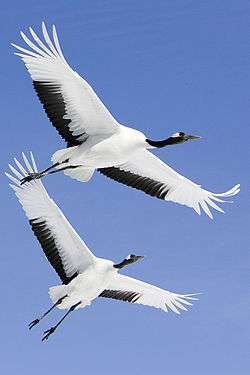
With their height averaging 1.5 m (5 ft), their large size deters most predators.[24] As a result, red-crowned cranes often react indifferently to the presence of other birds such as small raptors; with harriers, falcons, owls, and small buzzards being allowed to hunt small prey near a crane nest without any of these parties harassing each other. However, birds more likely to be egg or nest predators, such as corvids, some buzzards, and various eagles, are treated aggressively and are threatened until they leave the crane's territory. Mammalian carnivores, including gray wolves, red foxes, badgers, raccoon dogs, Eurasian lynxes, and domestic dogs, are attacked immediately, with the parent cranes attempting to jab them in the flanks until the predators leave the vicinity, sometimes killing smaller enemies such as foxes.[25] Occasionally, losses at the nest occur to some of the above predators. Introduced American mink on Hokkaidō are one of the most successful predators of eggs and nestlings.[26] Also, immature and unwary adult cranes may be killed by the largest raptors, such as sea eagles, or mammalian carnivores, though this is rare, especially with adults. White-naped cranes often nest near red-crowned cranes, but competition between these species for food in a common nesting area is lessened due to the greater portion of vegetation in the white-naped crane's diet.[27] In cases where interactions turn aggressive between white-naped and red-crowned cranes, red-crowned cranes are dominant, as expected due to their considerably larger size.[28]
Status
The population of red-crowned cranes is split into a migratory continental population in Korea, China, Mongolia, and Russia, and a resident Japanese population in Hokkaidō.[1][29] The estimated total population of the species is only 1,830 in the wild, including about 950 birds in the resident Japanese population.[1][30] Of the migratory populations, about 400-500 winter in China (mainly at the Yellow River delta and Yancheng Coastal Wetlands), and the remaining 1000-1050 winter in Korea.[1] It received endangered status on 2 June 1970.
The National Aviary in Pittsburgh, Pennsylvania, ran a program where U.S. zoos donated eggs which were flown to Russia and raised in the Khinganski Nature Reserve and released into the wild. This program sent 150 eggs between 1995 and 2005. The program has been put on hold to concentrate on different crane conservation programs in Russia, such as education and fire suppression. Several hundred red-crowned cranes are kept in zoos around the world.[31] Assuredly, the international efforts of Russia, China, Japan, and Korea are needed to keep the species from extinction. The most pressing threat is habitat destruction, with a general lack of remaining pristine wetland habitats for the species to nest. In Japan, little proper nesting habitat remains and the local breeding population is close to the saturation point.[2][17]
In South Korea, it has been designated natural monument 202 and a first-class endangered species.
Culture
China
In China, the red-crowned crane is often featured in myths and legends. In Taoism, the red-crowned crane is a symbol of longevity and immortality. In art and literature, immortals are often depicted riding on cranes. A mortal who attains immortality is similarly carried off by a crane. Reflecting this association, red-crowned cranes are called xian-he (traditional Chinese: 仙鶴; simplified Chinese: 仙鹤; pinyin: xiānhè; "fairy-crane" or "crane of the immortals""). The red-crowned crane is also a symbol of nobility. Depictions of the crane have been found in Shang Dynasty tombs and Zhou Dynasty ceremonial bronzeware. A common theme in later Chinese art is the reclusive scholar who cultivates bamboo and keeps cranes. Some literati even reared cranes and trained them to dance to guqin music.
Because of its importance in Chinese culture, the red-crowned crane was selected by the National Forestry Bureau of the People's Republic of China as a candidate for the title of national animal of China. This decision was deferred due to the red-crowned crane's Latin name translation as "Japanese crane".[32]
Japan

In Japan, this crane is known as the tanchōzuru and is said to live for 1,000 years. A pair of red-crowned cranes was used in the design for the Series D 1000-yen note (reverse side). In the Ainu language, the red-crowned crane is known as sarurun kamuy or "marsh-kamuy". At Tsurui, they are one of the 100 Soundscapes of Japan. Cranes are said to grant favours in return for acts of sacrifice, as in Tsuru no Ongaeshi ("crane's return of a favor").
Given its reputation, Jerry Huff, an American branding expert, recommended it as the international logo of Japan Airlines, after seeing a representation of it in a gallery of samurai crests. Huff wrote "I had faith that it was the perfect symbol for Japan Air Lines. I found that the crane myth was all positive—it mates for life (loyalty), and flies high for miles without tiring (strength).”[33]
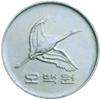
Robert Kuok's Kerry/Kuok Group also uses the red-crowned crane as its logo for operations in Hong Kong, Singapore, PR China, and overseas.
Korea
In Korea, the red-crowned crane is called durumi and it is considered a symbol of longevity, purity, and peace. Korean seonbis regarded the bird as an icon of their constancy. The red-crowned crane is depicted on the in Korean 500-won coin and is the symbol of Incheon.
See also
- Wildlife of China
- List of Special Places of Scenic Beauty, Special Historic Sites and Special Natural Monuments
- Izumi crane migration grounds, for a protected place in Japan visited by many migratory crane species
References
- BirdLife International 2016. Grus japonensis. The IUCN Red List of Threatened Species 2016: e.T22692167A93339099. https://dx.doi.org/10.2305/IUCN.UK.2016-3.RLTS.T22692167A93339099.en.
- Archibald G.W. & Meine, C.D. 1996. Family Gruidae (Cranes). In: del Hoyo J, Elliott A, Sargatal J. (Eds.). Hoatzin to Auks. Handbook of the Birds of the World. Vol. 3. pp. 60-89.
- del Hoyo, J. Elliott, A. and Sargatal, J.(1996) Handbook of the Birds of the World Volume 3: Hoatzins to Auks Lynx Edicions, Barcelona
- "Archived copy". Archived from the original on 28 January 2012. Retrieved 27 November 2012.CS1 maint: archived copy as title (link)
- "Archived copy". Archived from the original on 11 October 2012. Retrieved 14 December 2013.CS1 maint: archived copy as title (link)
- [BirdLife International (2000), Threatened Birds of the World, Lynx Edicions and BirdLife International, Barcelona and Cambridge] Red-crowned crane - ICF Archived 20 November 2005 at the Wayback Machine
- CRC Handbook of Avian Body Masses by John B. Dunning Jr. (Editor). CRC Press (1992), ISBN 978-0-8493-4258-5.
- Burnie D and Wilson DE (Eds.), Animal: The Definitive Visual Guide to the World's Wildlife. DK Adult (2005), ISBN 0789477645
- Wattled Crane profile (2011).
- Sarus Crane profile (2011).
- Inoue, M., Shimura, R., Uebayashi, A., Ikoma, S., Iima, H., Sumiyoshi, T., & Masatomi, H. (2013). Physical body parameters of red-crowned cranes Grus japonensis by sex and life stage in eastern Hokkaido, Japan. Journal of Veterinary Medical Science, 75(8), 1055-1060.
- Klenova, A. V., Volodin, I. A., & Volodina, E. V. (2008). Duet structure provides information about pair identity in the red-crowned crane (Grus japonensis). Journal of Ethology, 26(3), 317-325.
- "Welcome to Cyber Crane". Archived from the original on 22 July 2011. Retrieved 12 May 2008.
- The Wildlife Year, The Reader's Digest Association, Inc. (1991). ISBN 0-276-42012-8.
- Hongfei, Z., Yining, W., Qingming, W., Xiaodong, G., Meng, H., & Jianzhang, M. (2012). Diet Composition and Preference of Grus japonensis in Zhalong Nature Reserve During Courtship Period [J]. Journal of Northeast Forestry University, 6, 021.
- Britton, D. & Hayashida T. 1981. The Japanese crane: bird of happiness. Tokyo, New York, San Francisco: Kodansha International. 64 pp.
- Klenova, A. V., Volodin, I. A., & Volodina, E. V. (2007). The vocal development of the Red-crowned Crane Grus japonensis. Ornithological Science, 6(2), 107-119.
- Carpenter JW. 1986. Cranes (Order Gruiformes) In: Fowler ME. (Ed.) Zoo and wild animal medicine. Philadelphia, London, Toronto, Mexico City: W.B. Saunders Company. pp. 316-326.
- Ma, Y-C. 1981. The annual cycle of red-crowned crane. In: Lewis JC, Masatomi H. (Eds.). 1981. Crane research around the world: Proceedings of the International Crane Symposium at Sapporo Japan in 1980 and papers from the World Working Group on Cranes, International Council for Bird Preservation. Baraboo, WI: International Crane Foundation.
- Ling, Z., Yanzhu, S., Dajun, L. & Yang A. 1998. Plumage growth and molt sequence in red-crowned crane (Grus japonensis) chicks. In: Cranes in East Asia: Proceedings of the Symposium held in Harbin, People's Republic of China June 9–18. Open File Report 01-403. Fort Collins: U.S. Department of the Interior, U.S. Geological Survey.
- Klenova, A. V., Volodin, I. A., Volodina, E. V., & Postelnykh, K. A. (2010). Voice breaking in adolescent red-crowned cranes (Grus japonensis). Behaviour, 147(4), 505-524.
- Stott, K. (1948). Notes on the longevity of captive birds. The Auk, 65(3), 402-405.
- Wang, Z., Li, Z., Beauchamp, G., & Jiang, Z. (2011). Flock size and human disturbance affect vigilance of endangered red-crowned cranes (Grus japonensis). Biological Conservation, 144(1), 101-105.
- Vinter, S.V. 1981. Nesting of the red-crowned crane in the Central Amur Region. In: Lewis JC, Masatomi H. 1981. Crane research around the world: Proceedings of the International Crane Symposium at Sapporo Japan in 1980 and papers from the World Working Group on Cranes, International Council for Bird Preservation. Baraboo, WI: International Crane Foundation.
- USGS. 2006. The cranes: status survey and conservation action plan: threats: biological factors.
- Pae, S. H., & Won, P. (1994). Wintering ecology of red-crowned cranes and white-naped cranes Grus japonensis and G. vipio in the Cheolwon Basin, Korea. In The future of cranes and wetlands: Proceedings of the International Symposium. Wild Bird Society of Japan, Tokyo (pp. 97-196). Chicago.
- Lee, S.D., Jablonski, P.G. & Higuchi H. 2007. Effect of heterospecifics on foraging of endangered red-crowned and white-napped cranes in the Korean Demilitarized Zone. Ecological Research 22:635-640.
- Su, L. and Zou, H. 2012. Status, threats and conservation needs for the continental population of the Red-crowned Crane. Chinese Birds 3(3): 147–164
- Masatomi, Y., Higashi, S. & Masatomi, H. A simple population viability analysis of Tancho (Grus japonensis) in southeastern Hokkaido, Japan. Popul Ecol 49, 297–304 (2007)
- ISIS (2011). Grus japonensis. Version 28 March 2011
- Controversy over the red-crowned crane's candidacy for national bird status (丹顶鹤作为候选国鸟上报国务院 因争议未获批)
- Huff, Jerry (2011). Notes on Creation of Tsurumaru Logo. unpublished: self. p. 3.
Further reading
- Craft, Lucille. 1999. "Divided by Politics, United in Flight - Can Japan and Russia Resolve Their Differences Over the Remote Kuril Islands and Protect the Rare Red Crowned Crane?" International Wildlife. 29, no. 3: 22.
- Crane- Paul A. Johnsgaard (2011).
- Hayashida, Tsuneo (October 1983). "The Japanese Crane, Bird of Happiness". National Geographic. Vol. 164 no. 4. pp. 542–556. ISSN 0027-9358. OCLC 643483454.
External links
| Wikimedia Commons has media related to Grus japonensis. |
| Wikispecies has information related to Grus japonensis |
- BirdLife Species Factsheet
- Red-crowned crane (International Crane Foundation)
- Three White Cranes, Two Flyways, One World An educational website that links schools along the eastern whooping crane flyway in the United States with schools along the eastern flyways of the Siberian and red-crowned cranes in Russia and China.
- Japanese Crane (Grus japonensis) from Cranes of the World (1983) by Paul Johnsgard

